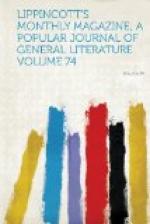The Bethel and Aurora communities—the former in Shelby county, Missouri, forty-eight miles from Hannibal, and the latter in Oregon, twenty-nine miles south of Portland, on the Oregon and California Railroad—were founded in 1848 by Dr. Kiel, a Prussian mystic, who practised medicine a while in New York and Pittsburg, and subsequently formed a religious sect of which these communists are members. He was subsequently joined by some of “Count Maximilian’s” people, who had left Rapp’s colony at Economy, which this closely resembles except as to celibacy. He first founded the colony in Missouri, where he took up two thousand five hundred and sixty acres of land, and established the usual trades needed by farmers. In 1847 there were the inevitable quarrel and division. In 1855 he set out to establish a similar community on the Pacific coast. The first settlement was made at Shoalwater Bay, Washington Territory, which was, however, subsequently abandoned for the present one at Aurora. There are now about four hundred members at Aurora, who own eighteen thousand acres of land, and have the usual shops and occupations of communists mentioned above, carrying on a considerable trade with their neighbors. The members of both communities are all either Germans or Pennsylvania Dutch, and thrive by the industry and economy peculiar to those people. Their government is parental, intended to be like God’s. Kiel is the temporal and spiritual head. Their religion consists in practical benevolence, the forms of worship being Lutheran. They are thought to be exceedingly wealthy, but if their property were divided among them there would be less than three thousand dollars to each family, which, though more than the property of most other communities would average, is but small savings for twenty years. They preserve the usual family relations.




